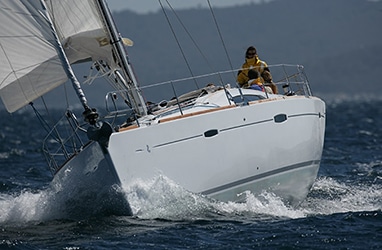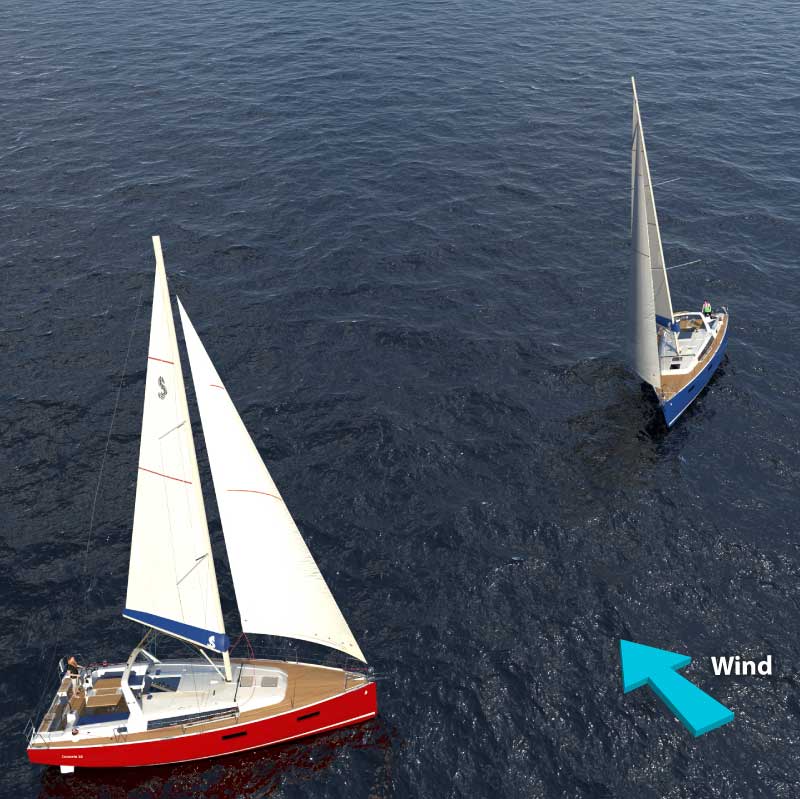
This article is an excerpt from NauticEd’s online FREE Navigation Rules Course, an interactive online sailing course for ALL sailors to learn Navigation Rules and become a safer sailor. Or if you want to learn more, upgrade to the Skipper Course Bundle to become a competent sailor!
You can learn to sail and improve your sailing with NauticEd, the international leader in sailing education.
Some Navigation Rules Terminology
Stand-On & Give-Way
We start with one vital and basic nomenclature. Worldwide, what is commonly and linguistically referred to as “Right of Way” on the land doesn’t exist on the water (with the exception of “Racing Rules of Sailing”). Instead, the term “Stand-On” replaces “Right of Way”. On land, we have very strict lanes to remain in and very strict intersection rules which give rise to easily being able to determine who has the rights at any point. Now imagine 100,000 cars all going in different directions at 100 km/hr on the salt flats of Utah. Well … let’s just say it wouldn’t happen for long. It would be mayhem! Thus, on the water, things are a little different. Fortunately, most of the time, the speed is less and the prudent and aware captain has time to make the proper decision according to the world-recognized rules for water traffic.
The technical difference then, between Stand-On and Right of Way is that the vessel who is NOT in the Give-Way position must act predictably in the eyes of the Give-Way vessel. I.E. the Stand-On vessel is first required to maintain course and speed (Stand-On) so that the Give-Way vessel can plot a safe crossing course. If collision becomes imminent, the Stand-On vessel is then REQUIRED to take all actions possible to avoid collision. Thus, it is at this point that the Stand-On vessel technically doesn’t have “rights” over the Give-Way vessel and thus the deletion of the term “Right of Way” on the water.
But what is Give-Way? It is clear inside the rules. If you are to Give-Way, you must keep clear of the other vessel and you must not impede its ability to continue to safely operate on its passage.
So to summarize this then: in any situation, you will either be the Stand-On vessel or the Give-Way vessel. If you are the Give-Way vessel you must take visibly obvious and early actions to allow the Stand-On vessel to know that by continuing current course and speed there will be no possibility of collision. If you are the Stand-On vessel you should initially hold course and speed but it is still your final responsibility to prevent collision.
To the beginner, this new terminology has been baffling as to why the change in language for a seemingly synonymous situation. However, the technical difference is valid and should be noted.
Starboard Tack – Port Tack
Only as sailors are we interested in this. It involves only the interaction between your sailboat and another sailboat. i.e. a power-driven vessel does not care where the wind is coming from and is not required to conform to any rules according to the wind. Since sailboats are driven by the wind they conform to standard navigation rules according to the wind when encountering one another.
Since the rules say a port tack boat must Give-Way to a starboard tack boat, we define those terms here. A discussion of the application of the rule follows this section.
For now, you must learn the definition of a starboard tack and a port tack and how to identify a boat on either.
- A sailboat is deemed to be on a port tack when the wind is coming over the port (left) side of the boat.
- A sailboat is deemed to be on a starboard tack when the wind is coming over the starboard (right) side of the boat.

The red boat on the left is said to be “on starboard” tack as the wind is coming over the starboard (right) side of the boat.
The blue boat on the right is said to be “on port” tack as the wind is coming over the port (left) side of the boat.
For boats heading directly downwind, the naming convention stays true to the above. It says “the opposite of whatever the mainsail is on”. As above, the red boat has its mainsail blown to port by the starboard wind – it is “on starboard”.
Below, the trailing boat has its main blown to port by a “starboard” wind. It is “on starboard”. Whereas the lead boat has its main blown to starboard by a port wind. It is “on port”. This is a fundamental of sailing. You MUST understand and learn this. The rules very much rely on these conventions and you must be able to instantly know at any time what tack you are on.

Basic Directions
Here are the ultra basics for those new to sailing. This video shows boats going across the wind, going into the wind (motoring), and sailing directly downwind. Note the boats “on-port” and “on-starboard”.
Leeward – Windward
Again, only as sailors are we interested in this. It involves only the interaction between your sailboat and another sailboat. When it comes to powerboats, the wind direction has no bearing on who gives way.
According to Wikipedia, the term lee derives from old English hleo, shelter, and was used as early as 900 AD. The lee side of a house was the sheltered side of the house – the downwind side. Toward the lee. Leeward! Thus on a boat, toward the lee side is the side of the boat that is furthest downwind.
Windward then is pretty obvious. It is toward the wind. In discussing other boats, there is a reference point taken. The reference point can be your boat, another boat, a buoy – anything. A windward boat is a boat more towards the wind than the reference point and a leeward boat is a boat more in the direction downwind of the reference point.
A leeward boat does not have to be directly downwind of another boat just that it is further downwind than the other boat.
So considering the above, you might say a boat is leeward of me. But they might not be directly downwind. To determine who is leeward, draw a line that is perpendicular to the wind. Then anything on the downwind side of that line is to the lee or leeward. Anything on the upwind side of the line is windward.

Above, boat “W” is windward of boat “L”. Conversely boat “L” is leeward of the boat “W”.
When sailing, it is an important distinction to know if you as a sailboat are leeward or windward of another sailboat because it determines who will have to Give-Way to the other.
In general, it is a given that a boat to windward is more able to maneuver than a boat to leeward because the windward boat generally has more options.
In a war, ships would gain an advantage over others by approaching them from the windward direction. And of further advantage, a leeward boat would be heeling over, presenting below the waterline planking to the windward boat. A cannon shot into this area would more easily sink the leeward ship.
Back to modern times. Rule 12 of the International Regulations of Preventing Collisions at Sea stipulates that the windward sailing vessel gives way to the leeward sailing vessel. This convention comes directly from the generality that the windward vessel is more maneuverable than the leeward vessel. Examples are shown in the following discussion of each rule. Snap test – in the above image, who gives-way?
Rule 3(c)- Sailboat Definition
Right now up front, we’re going to throw in Rule 3(c) to dispel any doubt:
3(c) The term “sailing vessel” means any vessel under sail provided that propelling machinery if fitted, is not being used.
Discussion
It means that as soon as you have your engines on, even if you have your sails up, you are a power-driven vessel according to the rules.
Learn Navigation Rules for Free...
A FREE 3-hour course that teaches how to stay safe, avoid collisions and accidents, and learn the “Rules of the Road”. The free Navigation Rules Course is for ALL sailors, whether you’re just learning or need a FREE refresher. Or, consider upgrading to the Skipper Course Bundle to become a fully competent skipper!
